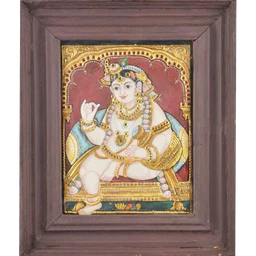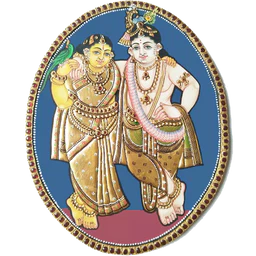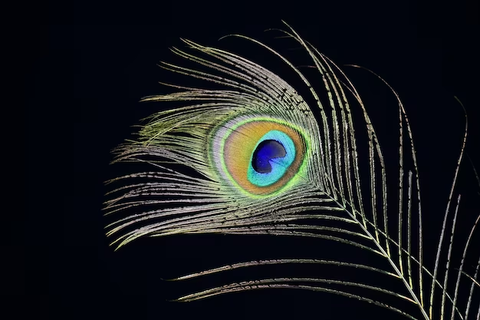Tanjore paintings, known for their intricate beauty, are beautiful artworks from South India. Importantly, these stunning pieces hold bright colors and shiny gold decorations. They often showcase gods, goddesses, and special stories from the Hindu religion. Consequently, through these paintings, you get a glimpse into the rich world of Indian culture and spirituality.
Moreover, buying online Tanjore paintings is a great way to make your home or office lively and extraordinary. They add a touch of color while bringing India's vibrant heritage to your surroundings. In this way, they serve as a unique and vibrant addition to your decor.
Celebrating Tanjore Krishna Paintings
Lord Krishna is a favorite theme for many Tanjore paintings, and artists often depict Him with distinctive symbolic elements:
- Peacock Feathers: To begin with, you will find Lord Krishna commonly wearing a crown adorned with peacock feathers in Tanjore Krishna paintings. These feathers symbolize his playfulness and his strong connection with nature.
- Flute: Tanjore Krishna paintings additionally have Lord Krishna holding a flute, which symbolizes his melodious music that captivated hearts and his ability to create harmony.
- Colorful Garments: Furthermore, the artists of Tanjore Krishna paintings dress him up in colorful garments, with yellow being his favorite color. This bright hue represents his divine nature and his connection with different aspects of life.
- Jewelry: You will find Him wearing a lot of jewelry in Tanjore Krishna paintings, including necklaces, bracelets, and earrings. These ornaments could be made of natural flowers or metal.
- Pot of Butter: Lastly, in many Tanjore paintings, you can see Lord Krishna with a pot of butter. This is because he is famously known for his love of stealing butter during his childhood, which adds a playful touch to his depiction.
Tanjore art brings out the intricate details of Lord Krishna's appearance and his playful nature, making it a distinctive and cherished representation of this beloved Hindu deity.

Significance of Peacock Feathers in Tanjore Krishna Paintings
In Tanjore Krishna paintings, peacock feathers aren't just beautiful decorations; they hold deep meanings. Lord Krishna, a young and playful god, is the central figure of these Tanjore paintings. Moreover, the peacock feather holds a special place in his life.
Legend has it that Lord Krishna loved to play his magical flute while surrounded by peacocks in the lush forests of Vrindavan. Furthermore, the peacocks danced with joy to his music, and Lord Krishna joined in, creating a scene of pure happiness. As a result, the feathers of these dancing birds became a symbol of that joyful moment and of Lord Krishna's love for nature.
The Symbolism of Colors in Tanjore Krishna Paintings
Peacock feathers are not only colorful but also rich in symbolism. To elaborate, green represents the Earth, symbolizing the deep connection between Lord Krishna and nature. Next, yellow symbolizes fortune and prosperity, illustrating Krishna's blessings for a good life.
Additionally, the color brown stands for stability and inner peace, serving as a reminder of the tranquility Lord Krishna brings. Lastly, the color blue represents the deep, dark skin of Lord Krishna, which is associated with his divine form. Together, these colors beautifully convey a message of harmony and happiness, making peacock feathers more than just beautiful decorations.

Peacock Feathers as a Crown in Tanjore Art
In Tanjore Krishna paintings, you'll often see Lord Krishna wearing a peacock feather crown. Notably, this crown tells a story of gratitude. When Lord Krishna danced with the peacocks, their cries made a melodious sound that reached the hearts of everyone in Vrindavan.
Furthermore, the king of the peacocks, deeply moved by this joyous occasion, approached Lord Krishna and bowed at his feet. In this simple and heartfelt act, he thanked Lord Krishna for creating a celebration of happiness. He offered his feathers as a symbol of their gratitude and asked Lord Krishna to wear them as a crown. As a result, Lord Krishna, always humble and kind, accepted this meaningful gift. Thus, peacock feathers became an essential and cherished part of Lord Krishna's divine appearance.

Vibrancy and Life of Tanjore Krishna Paintings
Peacock feathers add vibrancy to Tanjore Krishna paintings. Notably, they capture the viewer's attention and add life to the artwork. The feathers' iridescent colors shine, creating a sense of joy. Moreover, in the world of art, they provide a unique palette that painters use to bring Lord Krishna's playful spirit to life. The vibrant portrayal of these feathers is a testament to the artist's skill and devotion to accurately represent this symbol of grace.
Conclusion
In Tanjore Krishna paintings, peacock feathers hold a significance that goes beyond being mere ornaments; they serve as symbols of joy, nature, and the divine presence of Lord Krishna. Furthermore, the colors and stories associated with these feathers add depth and meaning to the artwork, forging a deeper connection between the viewer and the beloved deity.
Additionally, every time we admire a Tanjore God painting adorned with peacock feathers, we're reminded of Lord Krishna's playful and loving nature. This is beautifully encapsulated in these feathers, along with his deep connection with nature and the harmony he brings to the world. Consequently, with their vibrant colors and accompanying stories, peacock feathers stand as a beautiful way to celebrate the essence of Lord Krishna in the world of art.
If you want to purchase beautiful Tanjore Krishna Paintings, just visit Mangala Tanjore Paintings . You'll find a wide variety of online Tanjore paintings that can add a touch of Indian culture and spirituality to your space.




